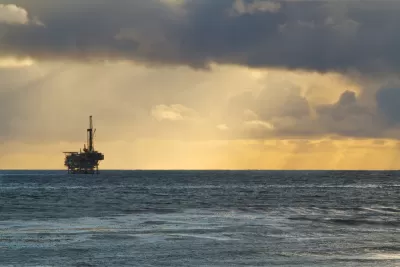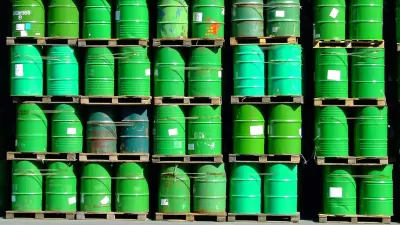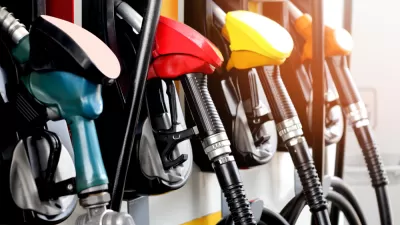Oil prices crashed Monday due to a disagreement between two of the world's largest oil producers, Saudi Arabia and Russia, amidst a slump in oil demand due to the outbreak of the coronavirus pandemic. Oil will flood the market as demand drops.

"The threat of a coronavirus-fueled oil war and ongoing panic around the outbreak brought markets to stunning lows Monday, triggering a forced halt to trading after the Standard & Poor’s 500 index sank 7 percent shortly after the opening bell," report , and "The Dow Jones industrial average cratered more than 2,000 points at the open, clawed back some losses, then drove the day’s lows to new depths."
Oil prices tumbled into the $30s, after Saudi Arabia and Russia deadlocked over production. The Saudis had been pushing for a cut in output to prop up prices, but reversed course when Russia balked and decided, instead, to flood the market with hundreds of thousands of additional barrels per day — a move analysts fear may trigger a price war.
"Markets are bracing for oil prices in the 20s," said one energy analyst in a Bloomberg News report on Monday's oil price plunge. That view was shared by Ali Khedery, a former State Department and Exxon Mobil adviser, who tweeted, "$20 oil in 2020 is coming," wrote POLITICO energy reporter, Kelsey Tamborrino, in her March 9 Morning Energy newsletter.
That means more pain for U.S. producers — and a newly aggressive Saudi Arabia to deal with in overseas markets that had just opened up to U.S. crude.
Effect on U.S. oil producers
"Now the fracking industry, which President Donald Trump sought to expand with hard-line support for increased fossil fuel production, faces potential ruin," reports Alexander C. Kaufman, who covers climate change, environmental policy and politics HuffPost.
Fracking, a ballyhooed but financially fragile sector, struggled to stay afloat with crude selling at $50 per barrel. If prices stay around $30, or even fall as low as $20, U.S. frackers simply might be unable to keep up.
“It’s a financial bloodbath,” said Clark Williams-Derry, an analyst at the Institute for Energy Economics and Financial Analysis. "With oil prices at the current level, there’s a real risk many of them will simply go bankrupt."
Kaufman elaborates on the fracking connection, noting the differences on the drilling strategy between the two leading Democratic presidential candidates, with Bernie Sanders pledging to ban it and Joe Biden who would limit or regulate it better.
Drawing an analogy with the coronavirus pandemic, Williams-Derry "likened the effect of low oil prices on U.S. frackers to an unhealthy person contracting the rapidly spreading coronavirus."
“You think of someone with a weakened immune system, and now they’re facing the coronavirus,” Williams-Derry said. “This was an industry that was already touch-and-go financially, already having severe difficulties managing debt loads. This just accelerates that problem, and brings all the other problems to the fore.”
It should be noted that fracking is a drilling strategy that applies to both oil and natural gas. It is not clear how a glut of oil will impact fracking for natural gas, which is a major issue for the swing state of Pennsylvania.
Hat tip to Dino Grandolino's Energy 202 PowerPost in The Washington Post.
Related in Planetizen:
-
Coronavirus Effects on Global Transportation System, March 9, 2020
FULL STORY: U.S. markets crater as coronavirus, oil prices trigger brief halt in trading

Planetizen Federal Action Tracker
A weekly monitor of how Trump’s orders and actions are impacting planners and planning in America.

Congressman Proposes Bill to Rename DC Metro “Trump Train”
The Make Autorail Great Again Act would withhold federal funding to the system until the Washington Metropolitan Area Transit Authority (WMATA), rebrands as the Washington Metropolitan Authority for Greater Access (WMAGA).

DARTSpace Platform Streamlines Dallas TOD Application Process
The Dallas transit agency hopes a shorter permitting timeline will boost transit-oriented development around rail stations.

San Francisco's School District Spent $105M To Build Affordable Housing for Teachers — And That's Just the Beginning
SFUSD joins a growing list of school districts using their land holdings to address housing affordability challenges faced by their own employees.

Car-Centric LA Suburb Looks to a Train-Oriented Future
City leaders in Rancho Cucamonga, the future western terminus of the Brightline West rail line to Las Vegas, want to reimagine the city as a transit-oriented, pedestrian-friendly community.

New Alaska Bitcoin Mine Would Burn as Much Energy as the State’s Largest Coal Plant
Fueled by “stranded” natural gas, the startup hopes to become the largest in the US, and to make Alaska an industry center.
Urban Design for Planners 1: Software Tools
This six-course series explores essential urban design concepts using open source software and equips planners with the tools they need to participate fully in the urban design process.
Planning for Universal Design
Learn the tools for implementing Universal Design in planning regulations.
Municipality of Princeton
Roanoke Valley-Alleghany Regional Commission
City of Mt Shasta
City of Camden Redevelopment Agency
City of Astoria
Transportation Research & Education Center (TREC) at Portland State University
US High Speed Rail Association
City of Camden Redevelopment Agency
Municipality of Princeton (NJ)




























